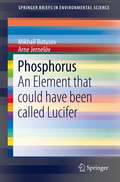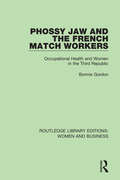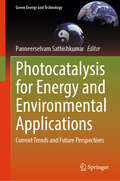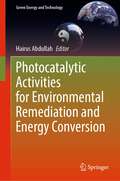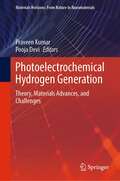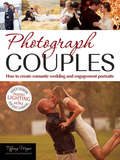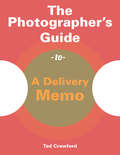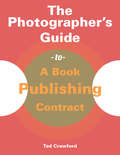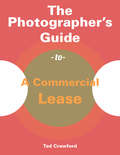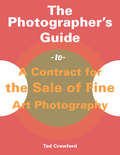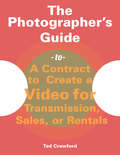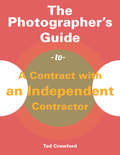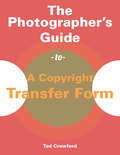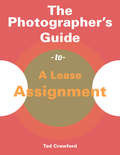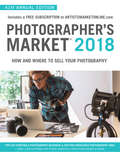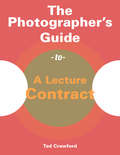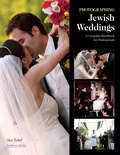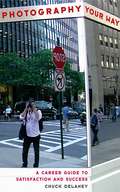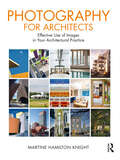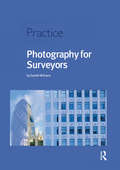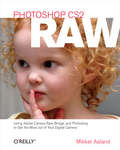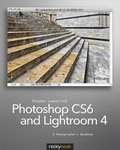- Table View
- List View
PhonePe: Democratizing Payments in India
by Rachna Tahilyani Michael ChuThe co-founders of PhonePe, India's leading digital payment platform are considering pursuing various growth opportunities in a huge country just entering the digital age. In a highly competitive industry, the founders are keenly aware that making the right choices is not only a matter of opportunity cost but critical to preserving the company's market leadership. PhonePe began as an enabling platform between parties and, unlike some of its competitors, did not get involved up to now in the direct delivery of goods and services. But PhonePe's brand and reach make it relevant now to revisit the question. In the next board meeting, three areas of obvious digital potential are likely to come up: lending, education and gaming. Another is taking the model international. What should the founders recommend to their board?
Phosphorus
by Arne Jernelöv Mikhail ButusovThis book starts with depiction of the phosphorus role in life creation and evolution. Then it outlines in which vital processes different phosphates participate in life of all flora and fauna, from DNA molecules till body tissues. Crucial function of phosphates was noticed long ago, but only in XIX century discovery of mineral fertilizers made it possible to sustain the needs of growing global population, thus initiating a "green revolution". Though, for many decades after it, the complexity of interactions "fertilizer-soil-plant roots" was underrated, causing massive damages, such as soil destruction and eutrophication of waters. Still, mining of exhausting natural phosphate reserves continued worldwide. Lessons of what happened in XIX century due to scarcity of phosphates were ignored. In the meantime, production of phosphates reached its peak few years ago. Immediate implementation of phosphate recycling technologies from municipal wastes can help avoid imminent global disaster.
Phossy Jaw and the French Match Workers: Occupational Health and Women In the Third Republic (Routledge Library Editions: Women and Business #4)
by Bonnie GordonThe 1898 suppression of white phosphorous in the French match industry was a victory of organized labour. At a time when most French workers did not have the power to effect changes in the health and safety conditions of their work, the match workers succeeded. At a time when most French women were not unionised and did not pursue effective action on occupational health problems, French women in the match industry succeeded. This book, first published in 1989, examines their actions and provides the definitive account of their success.
Photocatalysis for Energy and Environmental Applications: Current Trends and Future Perspectives (Green Energy and Technology)
by Panneerselvam SathishkumarThis book presents the existing photocatalytic reactor design and the future developments and the progress needed for both solar light-driven hydrogen generation and environmental purification. The chapters discuss the renewable and commercial aspects of translucent polymer-linked heterojunction nanocomposites as visible light-responsive photocatalysts. Relevant to these areas, the field of growing interest in black-TiO2, perovskites, MXenes and their numerous applications are presented. The framework, structural features and the need of mesocrystals for solar light-driven photocatalysis are also included. The book also discusses the additional features of green chemistry-based synthesis of nanomaterials in order to reduce any secondary pollution that may be released in the environment due to unsafe disposal of solvents. In addition, the importance of bismuth-based nanophotocatalysts towards energy and environmental applications and their future development as alternative photocatalysts for the prevailing nanomaterials are presented. The book also touches upon the idea to generate green fuel hydrogen through photocatalytic and photoelectrochemical techniques. Overall the book highlights contemporary developments in the last decade, the future perspectives of photocatalysis and its application towards energy and environment.
Photocatalytic Activities for Environmental Remediation and Energy Conversion (Green Energy and Technology)
by Hairus AbdullahThis book highlights sustainable methods with photocatalytic activities to remediate environment and for energy conversion. The related photocatalytic materials are discussed in detail. Some significant photocatalytic applications in degrading industrial pollutants that include different organic dyes, purifying the polluted air, converting CO2 to alcohol fuels, storing energy from sunlight as ammonia by converting N2 to NH3, and splitting water by optimizing the oxygen evolution process are thoroughly elucidated. The chapters introduce the necessary materials and results, leading to a better conceptualization in order to work in the field of photocatalysis. Some related perspectives and outlooks are discussed in the last chapter for possible future developments.
Photoelectrochemical Hydrogen Generation: Theory, Materials Advances, and Challenges (Materials Horizons: From Nature to Nanomaterials)
by Praveen Kumar Pooja DeviThis book describes the hydrogen fuel generation from water via photoelectrochemical process. It elaborates the theory and fundamental concepts of photoelectrochemistry to understand the photoelectrochemical process for water splitting to generate hydrogen fuel. The book further deliberates about the hydrogen as a futuristic chemical fuel to store solar energy in the form of chemical bonds and also as a renewable alternative to fossil fuels. The book establishes the need for hydrogen fuel and discusses the standards and practices used for solar driven photoelectrochemical water splitting. It also discusses the current and future status of the nanomaterials as efficient photoelectrodes for solar photoelectrochemical water splitting. The book will be of interest to the researchers, students, faculty, scientists, engineers, and technologists working in the domain of material science, energy harvesting, energy conversion, photo electrochemistry, nanomaterials for photo-electrochemical (PEC) cell, etc.
Photograph Couples
by Tiffany WayneWedding and portrait photography is a vast segment of the professional portrait industry. Those who cater to this demographic know that photographing couples during a very exciting period in their lives demands a unique skill-set-these sessions are done when emotions are high, in a wide range of locations, and under a staggering array of conditions. Still, the photographer must wrangle all of the variables to create images that flatter the subjects AND tell the story of their relationship. In this book, Tiffany Wayne presents 60 high-caliber images-each paired with gorgeous alternate poses-and detailed text showing readers how each image was conceived and orchestrated to flatter the couple and show their unique relationship to best effect. In 60 two-page spreads, readers will get a behind-the-scenes look at how the image came together. Wayne discusses her intent for each image, then shows the steps used to carry out her artistic vision-from positioning the individual subjects, to creating a physical bond, and eliciting emotion. Also detailed are the compositional choices that were made to reinforce and strengthen the portrait presentation. In the first part of the book, Wayne showcases engagement portraits-images made under more relaxed conditions when the pace of the day is not as hectic as it will be on the wedding day. In the second part of the book, Wayne turns her attention to wedding portraits of the couple. With the fresh, modern feel of Tiffany Wayne's images and her casual, seemingly effortless-yet perfect-posing approach, readers will find much to emulate in this book.
Photographer's Guide to A Delivery Memo
by Tad CrawfordPart of The Photographer's Guide series, this guide provides information about the issues relevant to photographers today. It discusses the transfer of photographic work from one party to another and how to ensure accountability and protection of ownership rights. Included are a sample delivery memo and a helpful negotiating checklist.
Photographer's Guide to Book Publishing Contract
by Tad CrawfordPart of The Photographer's Guide series, this classic guide provides information about the issues relevant to photographers today. It acts as a reference for photographer's contracts, negotiating, subsidiary rights publishers, as well as ebook publishers.
Photographer's Guide to a Commercial Lease
by Tad CrawfordPart of The Photographer's Guide series, this classic guide provides information about issues relevant to photographers today. It explains how to approach a commercial lease and what responsibilities one may encounter when renting for commercial purposes. This guide explains three types of leases (Form 20, 21, 22) and their provisions, includes a sample commercial lease contract, and contains helpful negotiation checklists.
Photographer's Guide to a Contract for the Sale of Fine Art Photography
by Tad CrawfordPart of The Photographer's Guide series, this classic guide provides information about the issues relevant to photographers today. It discusses the sale of fine art photographs to galleries, collectors, and dealers of photography. Included are a helpful negotiation checklist, a sample contract, and several provisions that can be added dealing with issues of resale, restoration, uniqueness, and more.
Photographer's Guide to a Contract to Create a Video for Transmission, Sales, or Rentals
by Tad CrawfordPart of The Photographer's Guide series, this guide includes information about the issues relevant to photographers today. It discusses the use of video for publicity, income, or educational purposes. This guide also includes a helpful negotiation checklist and a sample contract.
Photographer's Guide to a Contract with an Independent Contractor
by Tad CrawfordPart of The Photographer's Guide series, this guide includes information about the issues relevant to photographers today. Hiring an independent contractor-which is different from hiring an employee-requires alternate paperwork. This guide details important employee benefits, payroll taxes, and business expenses a photographer should know before hiring an independent contractor. Included are a helpful negotiation checklist and a sample contract.
Photographer's Guide to a Copyright Transfer Form
by Tad CrawfordPart of The Photographer's Guide series, this guide provides information about the issues relevant to photographers today. Learn about the basic parts of a copyright transfer form while completing a negotiation checklist and consulting a sample transfer form.
Photographer's Guide to a Lease Assignment
by Tad CrawfordPart of The Photographer's Guide series, this guide provides information about the issues relevant to photographers today. It explains the importance of picking an appropriate location for one's work space, whether it is a home studio for a small business or a rented space for a larger business. This guide includes a sample lease agreement as well as list of negotiation tactics, different types of leases, and varying legal forms for artists.
Photographer's Market 2018: How And Where To Sell Your Photography (Market #2018)
by Noel RiveraDiscover Powerful Secrets of Successful Photographers Thousands of successful photographers have trusted Photographer's Market as a resource for growing their businesses. This edition contains the most comprehensive and up-to-date market contacts for working professional photographers today: magazines, book publishers, greeting card companies, stock agencies, advertising firms, photo contests, and more. In addition to the more than 1,500 individually verified contacts, 2018 Photographer's Market includes:A free 1-year subscription to ArtistsMarketOnline.com, where you can search industry contacts, track your submissions, get the latest photography news, and much moreUp-to-date information on how to start and run a photography business, including how to find clients, who to contact to submit your photos, what types of photos they need, and how to submit both digital and film imagesMarkets for fine art photographers, including hundreds of galleries and art fairs, magazine and book publishers, contests, and moreInformative articles on business topics, such as maintaining records, customers service, trends in photography, gallery partnerships, and what makes a photo marketableInspiring and informative interviews with successful professionals, including wedding, concept, fashion and magazine photographers
Photographers Guide to a Lecture Contract
by Tad CrawfordPart of The Photographer's Guide series, this guide provides information about the issues relevant to photographers today. As lecturing can be an important source of income for many photographers, this guide can help ensure that everything goes smoothly. It describes specific details such as transportation, necessary materials, cancellation policies, and location, and includes a sample contract and negotiation checklist.
Photographing Jewish Weddings: A Complete Handbook for Professionals
by Stan TurkelA guide to the culture and traditions of Judaic ceremonies and receptions, this study offers photographers insight and advice for targeting and capturing Jewish weddings. Time lines and schedules are discussed with examples of start-to-finish wedding-day festivities, and a list of the essential images for the different types of weddings#151;such as Orthodox, Hasidic, Modern, Reform, and Conservative#151;emphasize the key elements photographers are not to miss. A special #147;Marketing 101 for Jewish Weddings” section helps photographers reach these potentially lifelong clients and reveals how these weddings, which sometimes fall on weekdays, can boost sales.
Photography Business
by Entrepreneur MagazinePicture Yourself a SuccessIf you have a talent for snapping great pictures, why not turn your hobby into a lucrative business? You can take portraits in a studio or on location, submit photos as a freelancer to newspapers and magazines, frame and display your favorite shots in a gallery, or record special events like weddings and sweet sixteen parties. No matter where your talents and interests lie, you can make a bundle from your work with this expert advice.Learn how to:Set up a functional studio and build a portfolioChoose the right equipment for all types of photos-and find great deals on the cameras and accessories you needFind paying jobs and market yourself professionallyGet great exposure for your work at art festivals, contests, galleries, local businesses and moreProtect yourself from legal concerns such as copyright infringement and privacy issuesWhether you want to earn a little extra money with a part-time business or set yourself up as a full-time, professional photographer, all the information you need to succeed is inside.This kit includes: Essential industry and business-specific startup steps with worksheets, calculators, checklists and more. Entrepreneur Editors' Start Your Own Business, a guide to starting any business and surviving the first three years. Downloadable, customizable business letters, sales letters, and other sample documents. Entrepreneur's Small Business Legal Toolkit.
Photography Careers: Finding Your True Path
by Mark JenkinsonPhotography Careers offers students an indispensable guide to beginning their professional journeys as photographers. This book presents the variety of career options available to those entering the competitive and comprehensive world of photography. With the insight and advice from industry mavens and the author himself, Photography Careers will help you change the way you evaluate your strengths as an artist and find your place in the photography community. Features include: Interviews with successful young professional photographer in a wide range of photographic specialties, from fashion photography to cinematography, and other industry related fields such as retouching, fine art sales, and photo editing Tips for how to find unique approaches in a saturated market Best practices for student looking at graduate programs, a budding career, and as a personal business
Photography Your Way: A Career Guide to Satisfaction and Success
by Chuck DelaneyThis book gives you straight-talking advice from a pro on how to build a successful career in photography, said PhotoSource International of the first edition of Photography Your Way. Now distinguished author Chuck DeLaney has updated this classic book to show how digital has increased the power of photography and broadened the options open to anyone who wants a career as a photographer. Rich with seasoned advice and practical tools for developing an individual style, this book is essential for emerging photographers.
Photography for Architects: Effective Use of Images in Your Architectural Practice
by Martine Hamilton KnightWe live in a world driven by images, but with so much visual noise, is anyone really looking? How does an architect ensure their portfolio is within view of the right audience? Photographs are still as vital to architectural practice as they ever were. However, creation and circulation, once in the hands of skilled professionals, is now perceived as being ‘free’ and within easy reach of all. But where is the clarity? What is the message? By setting out the case for curated image making, considered photography may again be placed at the centre of architectural marketing strategies. Photography for Architects guides the reader through various topics: from establishing a visual brand and sharing images online, to producing content in-house and commissioning professionals. It explores the still and moving image, creating books and exhibitions for legacy value, compiling award entries, and engaging with trade press. Little understood aspects regarding legal rights and obligations, ethics, copyright, and licensing images for use are discussed in clear language. Multiple photographic examples and conversations with international practitioners highlight the various themes throughout. Written by a working architectural photographer whose life has been spent in commercial practice, this easy-to-read, richly illustrated guide is essential reading for architects and designers alike who are working with images and image makers.
Photography for Surveyors (Eg Practice Ser.)
by Gareth EvansVisual images play an integral part in the surveying, development and sale of a property. However, obtaining high quality images can often prove a challenging task. Photography for Surveyors provides even the most amateur photographer with the skills required to produce the highest quality images in the day to day surveying environment. With the increasing importance of the visual portfolio and online presence, this book is an essential guide for all those professionals looking to enhance their skills with a camera, and subsequently raise their professional profile.
Photoshop CS2 RAW
by Mikkel AalandThe RAW file format is the uncompressed data file captured by a digital camera's electronic sensor. When your camera saves an image in RAW format, settings like white balance, sharpening, contrast and saturation are not applied to the image but are saved instead in a separate header. Because RAW files remain virtually untouched by in-camera processing, they are essentially the digital equivalent to exposed but undeveloped film. This makes RAW an increasingly popular format with amateur and professional digital photographers, because it affords greater flexibility and control during the editing process-if you know how to work with RAW files. Most digital camera manufacturers supply their own software for converting RAW data, as do some third party vendors. Increasingly, however, the RAW converter of choice is a plug-in included in the latest version of Adobe Photoshop, the most popular and widely-used digital image editing tool in the world. Adobe Photoshop CS2 is emerging as the best place to edit RAW images, and the best way to master this new format is with Photoshop CS2 RAW. An important book dedicated to working with RAW in Photoshop, this comprehensive guide features a unique design that helps readers grasp the subject through visual instruction and prompts. The entire RAW process is explored, from shooting to using the Adobe plug-in converter and new Bridge navigation software. The primary focus of Photoshop RAW is, as the title suggests, Photoshop editing technique: automating RAW workflow, correcting exposures, extending exposure range, manipulating grayscale and working with the new DNG (Digital Negative) open standard that Adobe supports. Presented by photographer Mikkel Aaland, a pioneer of digital photography and author of eight books, including O'Reilly's Photoshop for the Web and the award-winning Shooting Digital, Photoshop CS2 RAW investigates and instructs in an accessible visual style. Required reading for professionals and dedicated photo hobbyists alike.
Photoshop CS6 and Lightroom 4
by Stephen LaskevitchAdobe Photoshop is central to almost all photography workflows and Lightroom has rapidly been adopted as well. Each new version of the software is a milestone in the development of these vital imaging tools, and the 2012 releases are no exception. Photographers often feel overwhelmed when starting with Photoshop; the sheer number of tools and options make it difficult for the novice. There is no shortage of instructional books, yet very few direct the user to the most significant aspects of the program in a way that reflects a real workflow for the photographer. Adobe Certified Instructor Steve Laskevitch has leveraged his experience as a teacher and practitioner to create a guide that provides a clear and effective workflow for editing photographs in Photoshop CS6 and its companions Bridge, Camera Raw, and Lightroom 4. Focusing on the critical elements of the workflow rather than covering every arcane feature, this book is designed to get you working quickly in these applications. In addition to the essential features of these programs, Laskevitch covers new features specific to the 2012 releases, including: Lightroom geocoding-Quickly tag a photo with location data; Photoshop's Blur Gallery (Tilt-Shift, Iris, and Field Blur tools)-Add selective focus and bokeh effects; New development controls in Lightroom and Camera Raw; Recomposing or retouching photos with the Content-aware Move Tool; Publishing to Blurb directly from Lightroom; Video (no longer limited to Photoshop Extended; Adaptive Wide Angle-Make straight lines straight again; Face-Aware Mask Generation-An improvement to Color Range; Intelligent Auto-Correction; Adobe Camera Raw 7-Local controls for White Balance and Noise Reduction; New Black/White and Highlight/Shadow controls

